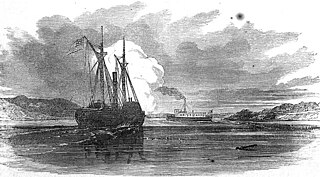
A tugboat or tug is a marine vessel that manoeuvres other vessels by pushing or pulling them, with direct contact or a tow line. These boats typically tug ships in circumstances where they cannot or should not move under their own power, such as in crowded harbour or narrow canals, or cannot move at all, such as barges, disabled ships, log rafts, or oil platforms. Some are ocean-going, and some are icebreakers or salvage tugs. Early models were powered by steam engines, which were later superseded by diesel engines. Many have deluge gun water jets, which help in firefighting, especially in harbours.

A. G. Prentiss was the 46 GRT wooden-hulled commercial vessel A. G. Prentiss launched 6 February 1912, by the Charles Ward Shipyard in Kennebunk, Maine, registered with official number 209585, for passenger service with home port at Saco, Maine. The vessel was named for Alfred G. Prentiss, owner of other tugs and a grain and groceries business. Despite the odd registration as "passenger" service when "tow" is one of the options, the vessel was well documented as a tug boat operating on the Saco River in Maine.

USS Algonquin, completed as El Toro in 1891 for the Southern Pacific Railroad's Morgan Line, was a small harbor tug commissioned by the United States Navy 2 April 1898. Renamed Accomac, after Accomac, Virginia, June 1898, renamed Nottoway in 1918 and, after the Navy adopted alphanumeric hull numbers on 17 July 1920, classified as YT-18, a district tug. On 5 October 1942 the name was cancelled and the tug was simply YT-18 until 1944 when classification was changed to YTL-18, a little harbor tug. Over the years as a Navy tug, from 1898 to 1946, the tug served from Cuba to Boston.
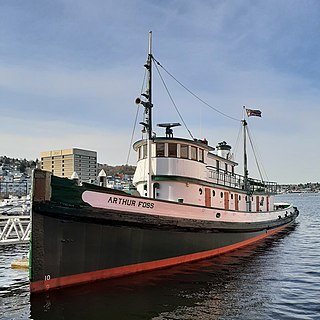
Arthur Foss, built in 1889 as Wallowa at Portland, Oregon, is likely the oldest wooden tugboat afloat in the world. Its 79-year commercial service life began with towing sailing ships over the Columbia River bar, and ended with hauling bundled log rafts on the Strait of Juan de Fuca in 1968. Northwest Seaport now preserves the tug as a museum ship in Seattle, Washington.
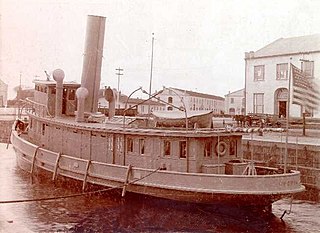
USRC Hudson, known for her service during the Battle of Cárdenas, was the United States Revenue Cutter Service's first vessel to have a steel hull and triple-expansion steam engine.

USS Redwing (AM-48) was an Lapwing-class minesweeper commissioned by the United States Navy for service in World War I. She was responsible for removing mines from harbors, and, in her role as rescue and salvage ship, she was responsible for coming to the aid of stricken vessels. She was laid down 5 August 1918 by the Baltimore Drydock & Shipbuilding Co., Baltimore, Maryland; launched 7 June 1919; sponsored by Mrs. Fred A. Plagemann, wife of the prospective commanding officer; and commissioned 17 October 1919.
USS Saffron was a small (73-ton) steamer purchased by the Union Navy during the beginning of the American Civil War.

SS Edward Luckenbach was the first of five new cargo ships to be built for the Luckenbach Steamship Company by Fore River Shipbuilding Corporation. The ship was launched in September 1916, delivered in November and briefly operated as such before being requisitioned for World War I service. The ship was one of the cargo vessels in the first large convoy transporting U.S. Army forces to France. After that convoy the ship served as a U.S. Army Chartered Transport (USACT) until converted by the Army to a troop ship and turned over to the Navy a few months before the war's end. The Navy commissioned the ship as USS Edward Luckenbach assigning the miscellaneous identification number ID-1662 in August 1918. The transport made one wartime voyage with continued voyages returning the Army to the U.S. until August 1919.

The fourth USS Fulton (SP-247), later USS SP-247, was a commercial tug built in 1909. She was commissioned by the United States Navy and served as a minesweeper in 1917 in the Third Naval District and returned to her previous owners two years later. She remained in service, latterly as Catherine Carroll, at least into the 1960s.

USS Sea Rover (SP-1014), later AT-57, was a United States Navy armed tug in commission from 1918 to 1921.
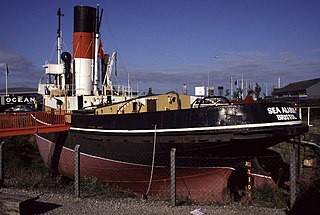
Admiralty tugs were tugboats built for and operated by the Royal Navy. These were vessels built to Admiralty specifications and in specific classes during the First and Second World Wars. They were built to meet the Royal Navy's demand for auxiliary vessels and to supplement the civilian tugs requisitioned by the Admiralty for war service.

The Gwendoline Steers was a tugboat owned by the Steers Sand & Gravel Company of New York, NY. It sank in an ice storm in Long Island Sound approaching the mouth of Huntington Bay, New York on December 30, 1962, with the loss of the entire crew of nine.
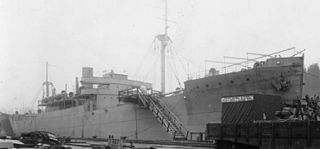
SS Jacona was an Emergency Fleet Corporation Design 1014 cargo ship launched in 1919 for the United States Shipping Board (USSB). In the glut of shipping after World War I, the ship was laid up until selected to be converted into the first specifically designed powership.

The Type V ship is a United States Maritime Commission (MARCOM) designation for World War II tugboats. Type V was used in World War II, Korean War, and the Vietnam War. Type V ships were used to move ships and barges. Type V tugboats were made of either steel or wood hulls. There were four types of tugboats ordered for World War II. The largest type V design was the sea worthy 186-foot (57 m) long steel hull, V4-M-A1. The V4-M-A1 design was used by a number of manufacturers; a total of 49 were built. A smaller steel hull tugboat was the 94-foot (29 m) V2-ME-A1; 26 were built. The largest wooden hull was the 148-foot (45 m) V3-S-AH2, of which 14 were built. The smaller wooden hull was the 58-foot (18 m) V2-M-AL1, which 35 were built. Most V2-M-AL1 tugboats were sent to the United Kingdom for the war efforts under the lend-lease act. The Type V tugs served across the globe during World War II including: Pacific War, European theatre, and in the United States. SS Farallon, and other Type V tugs, were used to help built Normandy ports, including Mulberry harbour, on D-Day, 6 June 1944, and made nine round trips to Normandy to deliver Phoenix breakwaters.

The Amboy was a wooden schooner barge that sank along with her towing steamer, the George Spencer on Lake Superior off the coast of Schroeder, Cook County, Minnesota in the United States. In 1994 the remains of the Amboy were added to the National Register of Historic Places.
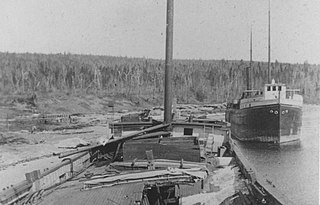
The AmboyandGeorge SpencerShipwreck Site is an archeological shipwreck site which consists of the wrecks of the wooden bulk freighter George Spencer and the wooden schooner-barge Amboy. Both vessels were wrecked during the Mataafa Storm of 1905. In 1994 the site was added to the National Register of Historic Places.
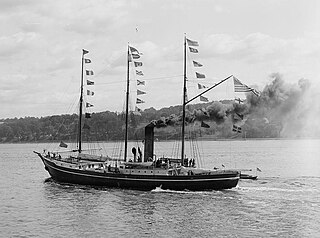
SS Roosevelt was an American steamship of the early 20th century. She was designed and constructed specifically for Robert Peary′s polar exploration expeditions, and she supported the 1908 expedition in which he claimed to have discovered the North Pole.

SS S.C. Baldwin was a wooden-hulled steam barge built in 1871, that capsized in a storm on August 26, 1908, on Lake Michigan, off Two Rivers, Wisconsin, United States, with the loss of one life. On August 22, 2016 the remnants of S.C. Baldwin were listed in the National Register of Historic Places as reference number 16000565.
M & J Tracy Inc. was a shipping and tugboat towing company founded in New York City by the racy brothers in 1881, as M & J Tracy Transportation company. The brothers: John Tracy, Michael J. Tracy and Thomas Tracy founded the Tracy Towing Line in 1917. The brother's sisters: Catherine Tracy and Helen Tracy were on the company's board. M & J Tracy Inc. office was located at 1 Broadway in New York City and had a field office in Brooklyn. The Tracy companies owned both owned tugboats and barges. Early work was transporting coal to New York harbor port in barges. M & J Tracy Inc. supported the World War II effort by operating United States tugboats and ships. After the war, M & J Tracy Inc. purchased some surplus ships. M & J Tracy Inc. also operated the M & J Tracy New York Harbor Industrial site. The family lived in the Frank J. Helmle 1912 Tracy Mansion at 105 8th Avenue, Brooklyn, New York, now a 7 unit Condo. John Tracy founded the Maritime Association of the Port of New York. John Tracy was born in 1855 and died on October 1, 1931. Michael J, Tracy died on November 7, 1927,

















